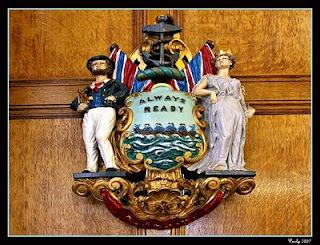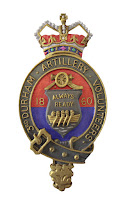 In 1859 the Volunteer Force was created as a result of rising tensions on the European continent. An appeal was made to citizens to form Artillery Corps and Companies in maritime towns. This appeal resulted in the formation of the 3rd Durham Volunteer Artillery in South Shields in 1860.
In 1859 the Volunteer Force was created as a result of rising tensions on the European continent. An appeal was made to citizens to form Artillery Corps and Companies in maritime towns. This appeal resulted in the formation of the 3rd Durham Volunteer Artillery in South Shields in 1860.
The first drill was carried out 27th March 1860, By the 31st March the strength had risen to 1 Captain, 2 Lieutenants, 4 Sergeants, 4 Corporals and 58 Gunners, giving a total strength of 66.
3rd Durham Volunteer Artillery March 1860
When the Royal Artillery divided in 1899, the unit became the 3rd Durham Royal Garrison Artillery (Vols).
On the formation of the Territorial Army in 1908, the 3rd Durham RGA re-rolled as Royal Field Artillery and designated as the 4th Durham Battery of the 4th Northumbrian (County of Durham) Howitzer Brigade RFA (T). The Brigade mobilised in August 1914 and deployed to France in April 1915. In early May, the Brigade were the first Territorial field gunners to engage in the Ypres fighting in the Second Battle of Ypres. A reorganisation of Field brigades in 1916 saw the 4th Durham Battery transferred to 250 (Northumbrian Brigade) as D/250 Battery, the 5th Durhams going to 251 Brigade, D/251 Battery. The units would go on to take part in the Battle of the Somme, Battle of Arras (1917) Battle of Passchendaele before the final battles of 1918.
On the re-forming of the TA in 1921 the brigade became the 3rd (Northumbrian) Field Brigade RA (TA), which was then re-designated as the 74th Field Brigade RA (TA).
 74 Brigade Bollingbroke Street Drill Hall
74 Brigade Bollingbroke Street Drill HallA re-organisation of Artillery Field Brigades in 1938 resulted in the formation of the 74th (Northumbrian) Field Regiment RA (TA) together with a duplicate unit, 125th (Northumbrian) Field Regiment RA (TA).
The 74th Regiment mobilised as divisional Artillery within the 50th (Northumbrian) Infantry Division, supporting 151st Infantry Brigade (United Kingdom) ,The Durham Light Infantry Brigade, with whom they served from 1939 to 1944 . They deployed to France in 1940 as part of the British Expeditionary Force (BEF). The Regiment returned to the UK in the Dunkirk evacuation.

In 1941 they embarked with the 8th Army for the Middle East Theatre of World War II. Initially they took part in the Jock column actions to harass the enemy. Supporting 151 (DLI) Brigade they were engaged in the Battle of Gazala, breaking out to avoid capture through Mersa Matruh, though suffering many casualties. Following re-fitting and re-equipment the Regiment was engaged in the Second Battle of El Alamein followed by the assault on the Mareth Line.
Joining the Italian Campaign (World War II) they landed in the Allied invasion of Sicily where they were engaged in the battle of Primosole Bridge (Operation Fustian)and the barrage across the Straits of Messina for the invasion of Italy.
The Regiments next major action was D-Day and the Invasion of Normandy, landing on Gold Beach with the 50th Northumbrian (Infantry) Division. They were subsequently involved in the Normandy Battle to breakout in Operation Perch. Later service through North West Europe saw the Regiment involved in the liberation of Brussels and the battle of the Gheil bridgehead on the Albert Canal. In September 1944 they formed part of Operation Market Garden. When the rest of the 50th Division returned to England, in November 1944, 74 Regiment was attached to 49th (West Riding Division) being engaged on the Grebbe line. Following the German surrender in May 1945 the Regiment remained in the Army of Occupation returning to South Shields in 1946.
The 74th (Northumbrian) Field Regiment fought with distinction in some of the most decisive battles of the Second World winning 3 DSO,7 MC, and 8 MM.
In 1947 the Territorial Army was reconstituted, 74 Regiment was re-formed as 274 (Northumbrian) Field Regiment RA (TA), with 125 Regiment formed as 325(Durham) L.A.A. Regiment R.A. (T.A.). Following subsequent amalgamations 325 Regiment became 463 (Durham Light Infantry) Light Air Defence Regiment R.A. (T.A.). On disbandment of Anti-Aircraft Command in 1955, 274 Regiment absorbed 487 H.A.A. Regiment R.A. (Durham) (T.A.) and 377 (Durham) Observation Regiment R.A. (T.A.).
In 1967 the TA became the Territorial Army Volunteer Reserve (TAVR). As part of this re-structuring 101 (Northumbrian) Medium Regiment RA (V) was formed. 205 Medium Battery was constituted from 274 Field and 463 LAA Regiments. In 1974 the honour title 3rd Durham Volunteer Artillery was adopted by the Battery.
Initially equipped with the BL 5.5 inch Medium Gun, they converted to 105mm Light Gun in 1980 and to FH-70 in 1991. The Battery was the last to fire 101 Regiment's guns during the prestigious Queens Cup which they won for the second year running. The Battery therefore concluded 137 years service on the guns of the Royal Artillery as the premier Gun Battery in the Territorial Army. The following year, in 1997, 205 Battery converted to a missile Battery equipped with M270 Multiple Launch Rocket System and became the first TA Battery to fire that weapon system.
The 74th (Northumbrian) Field Regiment fought with distinction in some of the most decisive battles of the Second World winning 3 DSO,7 MC, and 8 MM.
In 1947 the Territorial Army was reconstituted, 74 Regiment was re-formed as 274 (Northumbrian) Field Regiment RA (TA), with 125 Regiment formed as 325(Durham) L.A.A. Regiment R.A. (T.A.). Following subsequent amalgamations 325 Regiment became 463 (Durham Light Infantry) Light Air Defence Regiment R.A. (T.A.). On disbandment of Anti-Aircraft Command in 1955, 274 Regiment absorbed 487 H.A.A. Regiment R.A. (Durham) (T.A.) and 377 (Durham) Observation Regiment R.A. (T.A.).
In 1967 the TA became the Territorial Army Volunteer Reserve (TAVR). As part of this re-structuring 101 (Northumbrian) Medium Regiment RA (V) was formed. 205 Medium Battery was constituted from 274 Field and 463 LAA Regiments. In 1974 the honour title 3rd Durham Volunteer Artillery was adopted by the Battery.
Initially equipped with the BL 5.5 inch Medium Gun, they converted to 105mm Light Gun in 1980 and to FH-70 in 1991. The Battery was the last to fire 101 Regiment's guns during the prestigious Queens Cup which they won for the second year running. The Battery therefore concluded 137 years service on the guns of the Royal Artillery as the premier Gun Battery in the Territorial Army. The following year, in 1997, 205 Battery converted to a missile Battery equipped with M270 Multiple Launch Rocket System and became the first TA Battery to fire that weapon system.
The Battery currently provides reinforcements for Operation Herrick in Afghanistan. The first firing of MLRS in Afghanistan by a formed troop from the Territorial Army was fired by a detachment from 205 Battery.
 205 (3rd Durham Volunteer Artillery) Battery Royal Artillery (Volunteers)
205 (3rd Durham Volunteer Artillery) Battery Royal Artillery (Volunteers)
150th Anniversary 3rd Durham Volunteer Artillery
March past of 3rd Durham Volunteer Artillery Association, representative standards, 205 (3DVA) Battery RA (V), and Army Cadet Force. Salute taken by Mayor and Mayoress of South Tyneside, Honary Colonel and CO 101 Regiment Royal Artillery (Volunteers) South Shields Gazette Armed Forces Day
South Tyneside press release

